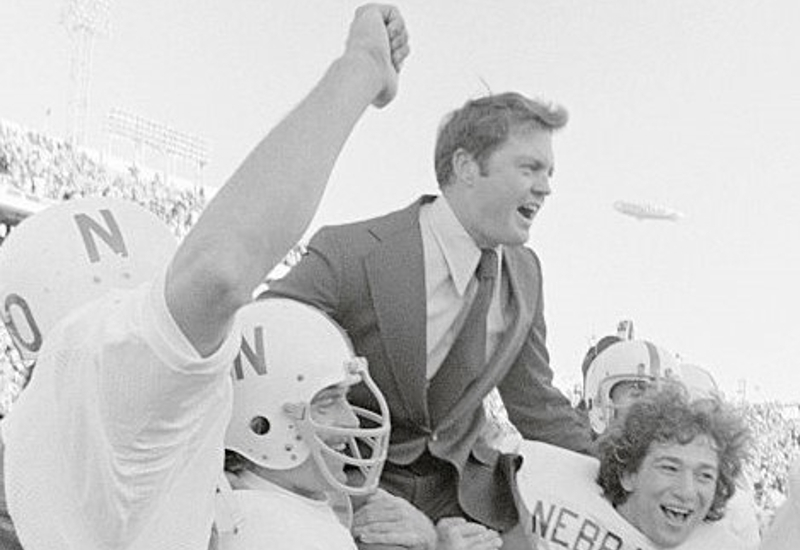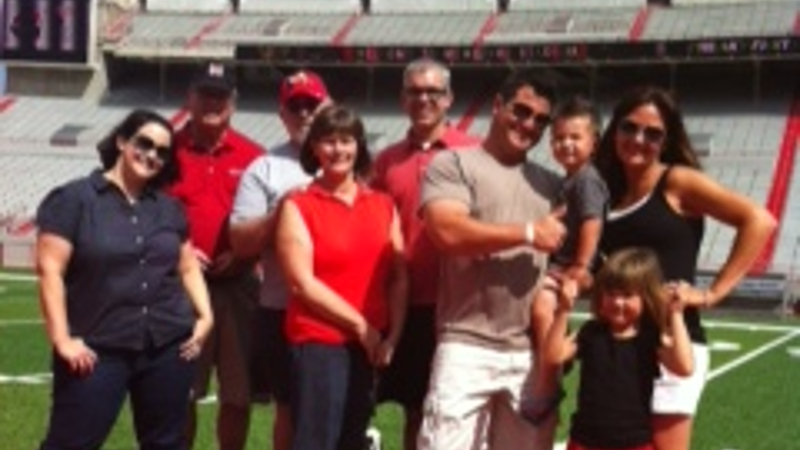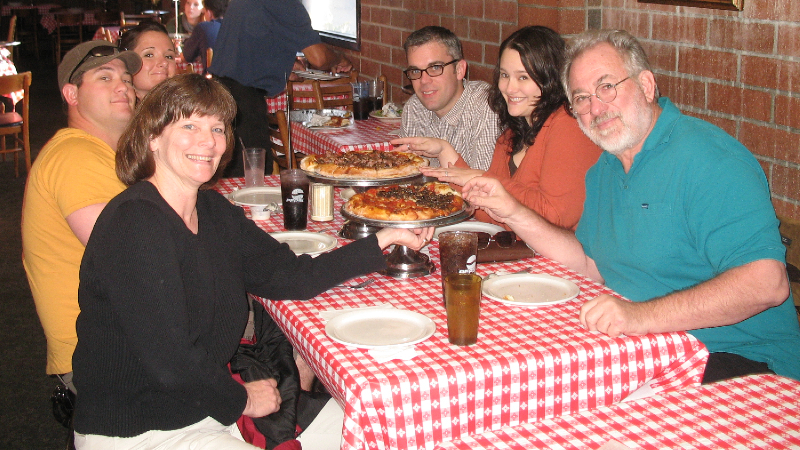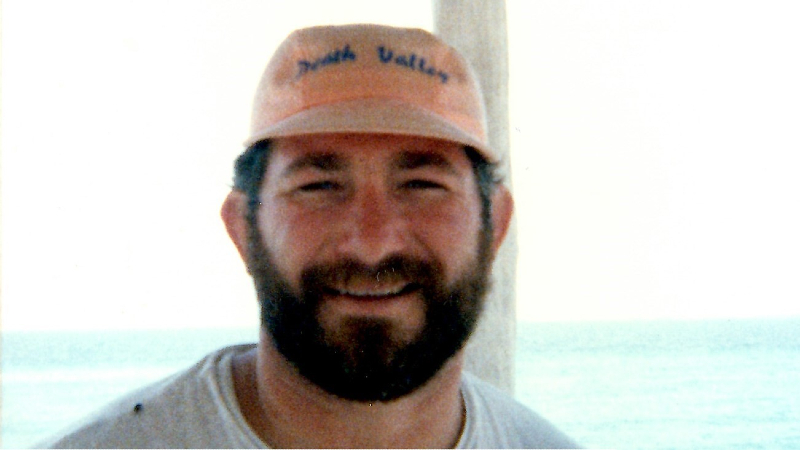Legacy Stories
By Jim Proebstle
The College Years
Since 1950, Nebraska Football has honored one of its players each year with the Tom Novak Award for a player that “best exemplifies courage and determination beyond all odds in the manner of Nebraska All-American center, Tom “Train Wreck” Novak.” John Bell earned the Tom Novak award in 1973 for playing the game with intensity—reckless abandon as the coaches called it. Fighting through injuries and personal setbacks, John, #66, was tough and a critical part of Nebraska’s 1971 National Championship team, 1972 Orange Bowl championship team, and 1973 Cotton Bowl championship team. This was in addition to his mention on the All-Conference and All-American academic award roster and to John being a two-year letter winner on the Husker wrestling team. Middle guards don’t often get that level of notoriety. John was blessed with exceptional quickness and power as he leveraged his 202-pound body among interior linemen of a much larger stature.

Raising a Family and Building a Career
John was known to have a strong work ethic, working through his teen and college years. He obtained a teaching credential from Nebraska. Wanting to work with adolescents, he started as a youth counselor with the California Youth Authority detention system. Family priorities changed and a move closer to family took John to high school teaching and administration for the majority of his career. He loved working with kids and connected with them at all levels through a knack for good ideas and resourceful programs. His spontaneous nature for making things happen enriched many young peoples' lives.
As children (Jared-son and Carrie-daughter), growing up with their father was always an adventure. He was always trying to introduce his children to new things and broaden their horizons. He challenged them every chance he got. He was at every game, every debate, every play, dance or choral recital, and every parent-teacher meeting. He was honest with his children and treated them with respect and listened whenever they had complaints and problems. Their communication was open and safe whether it be about sex, drugs or world events. John and his then-wife Paula divorced, and John insisted on joint and equal custody for his children in court.
He continued to include his children in his life even when he started dating his eventual second wife, Kathy. He always checked in with Jared and Carrie to make sure that they liked her. He even included the two kids on dates. John married Kathy in 1988 and they remained together until his death. Carrie and Jared were in the wedding and were also included on a family hiking trip/honeymoon—a “family-moon” long before it became trendy.
Carrie (Car-bear) and Jared (Jar-bear), as he called them, would attest to John’s level of enthusiasm via the many outdoor adventures and family trips as John’s reputation as papa-bear became legend. Until about 2007, Jared and Carrie would describe their dad was a bright shiny person. His Memorial Day parties were legendary. Their family and friends would gather. Everyone ate like kings, listened to music turned way up, and swam for hours. The kids were always going on road trips and encouraged to explore and try new things. He was firm and pushed the kids to their limits but was always kind and full of love and instruction. Carrie’s desire to see the world and live life fully were seeds planted by her dad. He also taught her how to be loyal and brave, to fight for the weak, and stand up to bullies. John was very proud of his kids.

As time went on, however, his lack of mobility and constant pain from arthritis restricted his need/desire to work out and remain physically active. The loss of this physicality in sports, which was so validating to John and so much a part of his youth, created issues. In his younger years, it was the physical contact inside and outside of wrestling and football that kept him focused.
John died on March 31, 2016 from a very aggressive onset of polyneuropathy, septic shock, coupled with complicating infections. The prognosis for recovery was not positive and after a week in ICU he was put on life support. Sadly, after two days of continued decline the family had to make the decision to take him off life support. Upon hearing of John’s passing many said that their lives would not be what they were today without John Bell. The family had just a small ceremony, but they received many cards, and Facebook posts in addition to the newspaper notice acknowledging John’s contributions.
Battling the Demons
John’s life was not easy, as his bi-polar II and ADHD diagnoses tormented him throughout adulthood. He just didn’t feel normal. Anger, irritability, binge drinking, hurtful comments, fault-finding, blaming, and rages triggered isolation. He often got very upset with friends and family and became disappointed with who they were. This led to negative comments as he would “just let them have it.” It was hard to recognize at times, and his kids internalized that this behavior was “not their father” and that he was not a “horrible person.” But it was painful to watch and also painful to be the brunt of the side effects. In an attempt to mask his demons, John’s risk-oriented personality lead him to more alcohol and recreational drugs. It was possible that the alcohol and drugs were a subliminal strategy to mask or suppress the undefined underlying medical issues. It was not a solution that worked and likely led to a psychotic break in his late 40s. Medication was prescribed but not always used.
His body wore down from the years of battle. With the loss of a physical outlet he turned to writing poetry and engaging in the arts more and more. But, as time passed the poetry became darker and darker and his trips to “outer space” went from once every six months to every couple of months. He would call his family several times a day at all hours of the day. He was always upset about things from the past, things that were unfinished or unresolved. Jared would sit and talk with him as much as he could. Sometimes John’s anger was directed at Jared for something he did or for not being there to answer his phone call. Most of the time he praised Jared for things he accomplished twenty years earlier or for the great father he was. He would end every call with, “love is love” and Jared responded with “not fade away.”

From their perspective, not being able to do as much physically made their dad grumpy and sad as he started cycling between being up and manic and down and depressed. He always had a fiery temper but it was easily provoked as he got older and deteriorated to where the littlest things would set him off. Maybe someone said the wrong thing or you slept in too late while visiting or weren't ready to walk out the door the moment he was. Or, he would call within minutes of the last call and his messages would usually start nice and normal and then would get angrier. In the last few years he had left some pretty accusatory messages and would often call them names or swear at them. He started to act paranoid about how we were not being loyal enough or grateful enough.
John was not great at taking his bipolar medication because he didn't like being “flattened out.” It wasn't him, but then again neither was the person he was becoming. At a certain point we always wondered what dad we were going to get when the phone rang or when we went to visit. These rages within the family would lead Kathy to warn the kids that John was in “crazy land right now” and not to try to deal with him. Often, the events involved a very specific timeline that wasn’t honored and John would become unhinged. It was as if the unresolved details themselves would upset him. At times, John’s desire for closure would trigger an almost “stalking” response to get things settled. The many layers to the issues he was dealing with made productive employment unrealistic.
Kathy, John’s constant companion and soulmate, sought support in counseling, visits to AA and Kaiser with John, visits to Al Anon on her own and the loving support of friends and family to cope with the many challenges. Naturally, social contact with others disappeared with John’s difficult interpersonal issues.
Carrie and Jared struggled to reconcile the idea that they had grown up so loved and supported and with so much magic and fun only to see the last 20 years end with what seemed like a totally different person as a father. The family saw John’s great big smile less and less, heard that jolly uncontrollable laugh less and less.
In the last two years of his life John spent more time lost in his head than with the rest of his family. He and Kathy would come visit for a day to watch the grandkids play sports. But after a few hours, he would get antsy and was ready to go. He never seemed 100 percent at ease with his surroundings. It was like the man they grew up with was trapped inside. The changes happened slowly at first, but as time passed, the decline of the man his children had called dad sped up with every year. They would all agree that one day he was his normal self and then suddenly it seemed like a switch had been flipped and he had a different personality. With sadness, anger, and confusion as a forefront to his emotions—complications set in with continued self-medication with alcohol. His love for his family was never a question. It was always there, but sometimes residing too far down to be seen.

Donating John’s Brain
After seeing the movie, Concussion, it was Carrie that made the connection with John’s behavior issues and CTE. When we realized he wasn’t going to make it, Kathy contacted Boston University’s Chronic Traumatic Encephalopathy (CTE) Center, as well as Lisa McHale at the Concussion Legacy Foundation (CLF) to find out if they would take John’s brain after he died. Both Boston University and CLF were enormously helpful in their efforts and in time John was diagnosed with Stage III-IV CTE. With this diagnosis, the family achieved a sense of peace and forgiveness in having to take John off life support. There was a sense of reconciliation with the two dads whom they had come to experience. Part of what made it so hard for his family was that John had always been a pillar of strength and athleticism. He was rarely sick and he recovered quickly. He was always active, athletic and strong—in the end he was none of those things.

How has your attitude toward football changed?
Kathy remains steadfast in her support for football. She feels strongly that football provides an outlet or release for the aggression needs of many young men. The physical nature of the game, while not for everyone, is perfect for some. While her concussion awareness is much better today, she hangs onto the hope that the equipment will continue to become better and that testing of athletes will help improve the player safety aspect of the game. She is optimistic that we can become smarter and that the game will evolve.
Jared’s wife now worries about him with the eight concussions he experienced over his playing time.
Carrie feels that John’s story is important for people to read so they can understand that CTE can happen, even if the athlete did not play professional football in the NFL.
Love is Love…
Not Fade Away
Copyright © 2017, James Proebstle
You May Also Like

Although we cannot yet accurately diagnose CTE in living people, a specialist can help treat the symptoms presenting the most challenges.
CTE Treatments